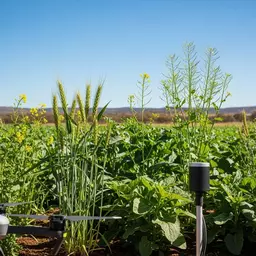Importance of Plant Genomics
- Biodiversity Conservation: Identifies & preserves endangered species.
- Industry Innovation: Develops resilient crops.
- Sustainable Practices: Enhances soil health, reduces chemical use.
Core Driver
What if the future of agriculture hinged on understanding the very genetics of our plants? In Australia, that future is being shaped by genetic innovation research databases, offering vital insights into biodiversity, conservation, and industry resilience.
Australian plant research relies on critical databases to drive advancements in biodiversity, conservation, and industry innovation. Understanding their roles and effective access methods is crucial for researchers.
Core Driver
Data Hubs
Process Flow
Efficiency & Analysis
As we delve into the fascinating world of plant science, it’s essential to understand the role of genetic innovation research databases in Australia. These databases serve as vital resources for researchers, students, and sustainability professionals alike, providing access to invaluable genetic data that can drive advancements in biodiversity, conservation, and industry innovation. At Plant Frontier Insights, we recognize that harnessing this data can lead to a more resilient agricultural future for Australia.
Plant genomics plays a crucial role in understanding the intricate relationships between plants and their environments. By analyzing genetic information, we can enhance biodiversity conservation strategies and support innovative practices within various industries. Imagine the potential of utilizing genomic data to strengthen our food systems and improve pest management strategies in the face of climate challenges!
In Australia, plant genomics is fundamental for several reasons:
For instance, the study of native species helps inform restoration projects, allowing us to reintroduce plants that are better adapted to changing climates. These innovations are more than just scientific endeavors; they represent a commitment to preserving our unique flora for future generations.
Several key databases are critical for supporting Australian plant research. These databases serve diverse purposes and hold significant importance:
Utilizing these databases allows researchers at institutions like the Australian National University and CSIRO to conduct impactful studies that advance our understanding of plant science. By integrating diverse data sources, we can fuel innovation and address the pressing challenges facing Australia’s ecosystems.
As we explore how to effectively navigate these vital databases, I want to share some practical steps that can ease your journey. Accessing the right data is crucial for driving your research forward, and being familiar with these resources will enhance your efforts.
Whether you're a seasoned researcher or just starting your journey in plant sciences, understanding how to utilize these tools is key. Let's dive into some actionable steps to help you get started!
Accessing genomic databases may seem daunting at first, but it can be straightforward with a clear approach. Here’s a simple guide to help you access the Genomics for Australian Plants Data Portal:
By following these steps, you'll be well-equipped to tap into a wealth of information that can aid your research projects.
Effective data searching within these databases is essential for obtaining the information you need. Here are some best practices to enhance your querying experience:
Implementing these techniques can significantly improve the efficiency of your research process. Remember, even small adjustments in your searching tactics can lead to more fruitful results!
In addition to databases, various bioinformatics tools and platforms can enhance your research capabilities. These tools are designed to help you analyze and visualize genomic data effectively:
These resources play a critical role in advancing plant genomic research. For more insights into how genetic innovations are shaping sustainable farming practices, explore genetic innovation in sustainable farming methods. By leveraging these tools, you can unlock deeper insights into plant genetics and contribute to meaningful advancements in sustainability.
Collaboration with prominent institutions is vital to advancing research in plant genomics. Institutions like the Australian National University and CSIRO play significant roles in this field:
Engaging with these institutions can provide researchers with the support and resources necessary to drive impactful research projects. As we work together, we can enhance Australia’s agricultural resilience and sustainability.
To maximize your efficiency when working with genetic databases, consider creating a list of specific research questions ahead of your search. This focused approach not only saves time but also helps in honing in on the most relevant data, leading to more impactful research outcomes.
Understanding and accessing genetic innovation databases is crucial for advancing plant science in Australia. These databases serve as essential tools for researchers, providing valuable genetic information that supports biodiversity conservation, industry innovation, and agricultural resilience. By leveraging these resources, we can foster deeper insights into plant genomics, ultimately contributing to a more sustainable future.
To summarize, key points about accessing these databases include:
As we at Plant Frontier Insights continue to advocate for sustainable agricultural practices, understanding these databases becomes even more vital in our collective efforts toward enhancing Australia's ecosystems.
As you embark on your research journey, I encourage you to utilize the databases and tools we discussed. These resources not only enhance your understanding of plant genomics but also facilitate practical applications in your work. Start by exploring the Genomics for Australian Plants Data Portal, which is a fantastic entry point for accessing genomic data.
Consider these next steps:
By taking these steps, you’ll not only enhance your research capabilities but also contribute to a more collaborative scientific community.
To further support your exploration of genetic databases, I've compiled some valuable resources that can aid in your learning:
These resources provide essential guidance as you navigate the complexities of accessing genomic data. Don’t hesitate to reach out to the contacts provided for personalized assistance!
Collaboration is key in the field of plant science. Organizations like the Australian Society of Plant Scientists and the National Biodiversity Network play vital roles in facilitating connections among researchers. By participating in these networks, you can:
These networks not only enhance your research experience but also contribute to the broader mission of fostering innovation and sustainability within the agricultural sector. To understand the broader impact of such collaborations, consider exploring plant science advances in Australia.
Here is a quick recap of the important points discussed in the article:



 As the agricultural landscape in Australia evolves, the role of genetic innovation tools becomes inc
As the agricultural landscape in Australia evolves, the role of genetic innovation tools becomes inc
 As the agricultural landscape in Australia faces mounting challenges, understanding effective crop p
As the agricultural landscape in Australia faces mounting challenges, understanding effective crop p
 As Australia faces growing agricultural challenges, the significance of biosecurity cannot be overst
As Australia faces growing agricultural challenges, the significance of biosecurity cannot be overst
 As we delve into the intricate world of biosecurity, consider this: the health of Australia’s ecos
As we delve into the intricate world of biosecurity, consider this: the health of Australia’s ecos